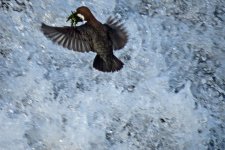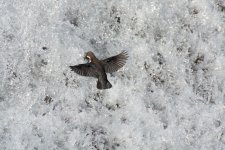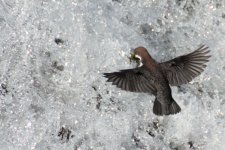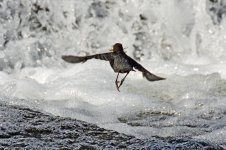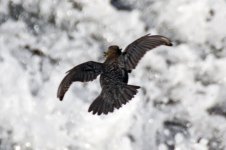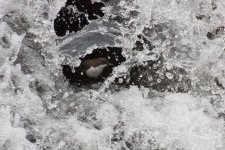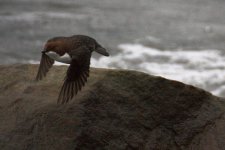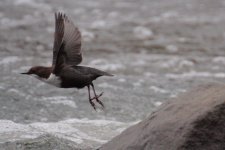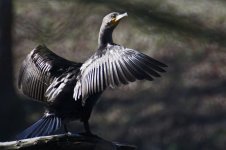[...] If you do rethink this, KEH is one of the best online used camera gear sites, and my "Bargain" grade T4i came with only a scuff over the model name. Also, remember that with a Canon DSLR you get a 1.6x crop factor, so that a 300mm lens turns out to be a 480mm equivalent. Don't forget to look at Third-Party lenses too which can, in some cases, be superior to their name brand equivalents. One to look into is the Tamron 70-300 (
this one), which I've seen many good photos taken with. Hope I didn't confuse you too much!
By sheer coincidence, I own this combo: Canon Rebel T4i (= 650D in Europe), Tamron 70-300mm and Kenko TC 1.4x. There are situations when this combo easily beats my SX50, quality-wise. For example a Dipper flying through a waterfall, the SX50 here suffered from its limited "speed", the photos of the dslr were soo much better. On the other side, in most normal situations the birds are simply too small with this dslr combo. That was the main reason why in the last 3.5 years I have almost exclusively used the SX50. In most respects the SX50 and the OP's SX60 are very similar, and for people who prefer the birds filling the viewfinder, the Tamron 70-300 cannot be the best choice.
If we talk "budget" and allow buying second-hand, the Canon 4ti (650D) + Kenko 1.4x + Tamron 150-600 would cost about Euro 1000. After removing the collar of the Tamron, the combo weights about 2.4 kg and its "reach" would be 1344 mm, similar to the SX60.
I've heard much praise for the Canon 400mm f/5.6 L lens (Vespobuteo's advice), it can also be combined with a Kenko 1.4x (or maybe a 2.0x?) and weighs 500g less. Surely a factor for extended walks. - In both cases it is an expensive pleasure, even more so if you prefer to buy new or want a Micro Four Thirds.
Maybe "silent" should be a factor, too - does this matter to you, CalvinFold? My 650D is loud, a majority of the "close" birds will flee immediately when I start shooting. I've met someone in a birding reservation carrying a 5d3 + Tamron 150-600, and he proudly demonstrated the "silent mode" which this camera has. Indeed, Canon's "silent mode" is a huge improvement: the noise is of a lower frequency, and I guess 70% of the closer birds would "remain". Of course, the Canon 5d3 costs Euro 2.300 or so, and the new 7d2 is still at Euro 1.300. Quite a difference to the 650D (about Euro 300, used).
I don't know much about MFTs; Panasonic's G7 is said to have a silent mode.
Edit: Sample photos to prove the superiority of a DSLR over the SX50 when it comes to the (admittedly very special) situation of a dipper nesting behind a waterfall.
The first photo (hardly cropped, edited in Photoshop) was taken with the SX50 in "high speed burst mode", since I was struggling to get these fast-flying birds into focus with TV mode. Burst mode = only 1/1000 sec, so maybe I should have tried TV mode with 1/1600 sec, no TC. But even in burst I needed luck to hit the bird...
The second photo (two versions: RAW via DPP / edited in Photoshop) was taken with the combo Canon 450D, Kenko 1.5x, Tamron 70-300. [So it wasn't my 650D, but the 650D is just a little better in some respects.] It was obviously easier to find the bird, because the photographed area is larger.

In this second case I used 1/2500 sec in TV mode, the 450D can go up to 1/4000 sec if necessary.
In both cases (SX50 or DSLR), a more experienced photographer might achieve better results. But my point was simply a comparison of the two set-ups from exactly the same distance, light, etc.






